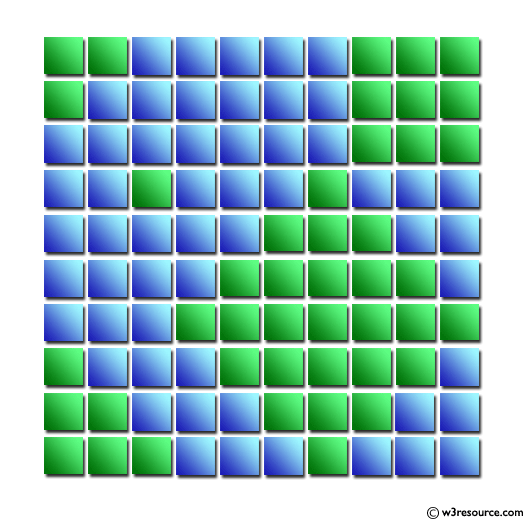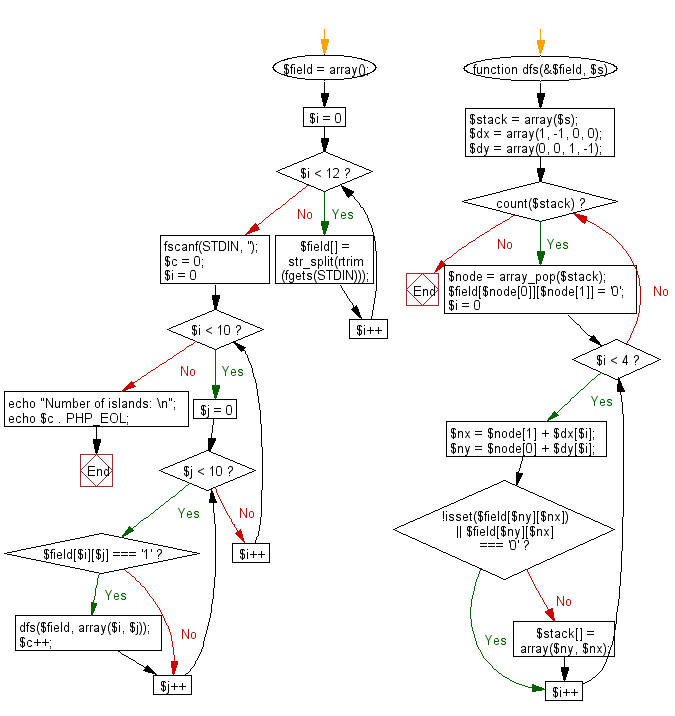PHP Exercises: Read the mass data and find the number of islands
71. Island Counting
There are 10 vertical and horizontal squares on a plane. Each square is painted blue and green. Blue represents the sea, and green represents the land. When two green squares are in contact with the top and bottom, or right and left, they are said to be ground. The area created by only one green square is called "island". For example, there are five islands in the figure below.
Write a PHP program to read the mass data and find the number of islands.
Input: A single data set is represented by 10 rows of 10 numbers representing green squares as 1 and blue squares as zeros.
Pictorial Presentation:

Sample Solution:
PHP Code:
<?php
// Function to perform Depth-First Search (DFS)
function dfs(&$field, $s) {
// Initialize a stack with the starting position
$stack = array($s);
// Define movement directions: right, left, down, up
$dx = array(1, -1, 0, 0);
$dy = array(0, 0, 1, -1);
// Continue DFS until the stack is empty
while (count($stack)) {
// Pop a node from the stack
$node = array_pop($stack);
// Mark the current node as visited
$field[$node[0]][$node[1]] = '0';
// Explore neighbors in all four directions
for ($i = 0; $i < 4; $i++) {
$nx = $node[1] + $dx[$i];
$ny = $node[0] + $dy[$i];
// Check if the neighbor is within the field and is unvisited
if (!isset($field[$ny][$nx]) || $field[$ny][$nx] === '0') {
continue;
}
// Push the neighbor onto the stack for further exploration
$stack[] = array($ny, $nx);
}
}
}
// Main code block
{
// Initialize a 2D array to represent the field
$field = array();
for ($i = 0; $i < 12; $i++) {
$field[] = str_split(rtrim(fgets(STDIN)));
}
// Read an extra line to handle any remaining newline characters
fscanf(STDIN, '');
// Initialize a counter for the number of islands
$c = 0;
// Iterate through the field
for ($i = 0; $i < 10; $i++) {
for ($j = 0; $j < 10; $j++) {
// If an unvisited '1' is found, perform DFS and increment the island counter
if ($field[$i][$j] === '1') {
dfs($field, array($i, $j));
$c++;
}
}
}
// Output the number of islands
echo "Number of islands: \n";
echo $c . PHP_EOL;
}
?>
Explanation:
- Define Depth-First Search (DFS) Function:
- dfs(&$field, $s): A function for performing DFS to explore an area, marking connected "1"s as visited.
- Initialize Stack: Starts with the initial position $s.
- Define Directions: Sets four movement directions (right, left, down, up) for exploring neighbors.
- DFS Loop:
- Continues until the stack is empty.
- Pops a node from the stack and marks it as visited by setting its value to '0'.
- Neighbor Exploration:
- Checks each direction to find unvisited nodes within bounds that contain '1'.
- Pushes any valid neighbors onto the stack to continue DFS.
- Initialize Field:
- Creates a 2D array $field by reading 12 lines from standard input, where each line is split into characters.
- Reads an extra line to handle any remaining newline characters in the input.
- Count Islands in Field:
- Initializes $c to count islands.
- Nested Loop:
- Iterates through each cell in a 10x10 subset of the $field.
- If an unvisited '1' is found, calls dfs($field, array($i, $j)) to explore the entire connected region and increments the island counter $c.
- Output Result:
- Displays the total number of islands found in the field.
Sample Input:
1100000111
1000000111
0000000111
0010001000
0000011100
0000111110
0001111111
1000111110
1100011100
1110001000
Sample Output:
Number of islands: 5
Flowchart:

For more Practice: Solve these Related Problems:
- Write a PHP script to identify and count islands in a 2D grid using recursive flood fill.
- Write a PHP script to determine the number of islands in a grid where islands are only defined by horizontal and vertical connections.
- Write a PHP script to compute the area of each island and output the island with the maximum area.
- Write a PHP script to label each island uniquely in a grid and count the total number of distinct islands.
Go to:
PREV : Customer Trading Analysis.
NEXT :
Compressed String Restoration.
PHP Code Editor:
Have another way to solve this solution? Contribute your code (and comments) through Disqus.
What is the difficulty level of this exercise?
Test your Programming skills with w3resource's quiz.
